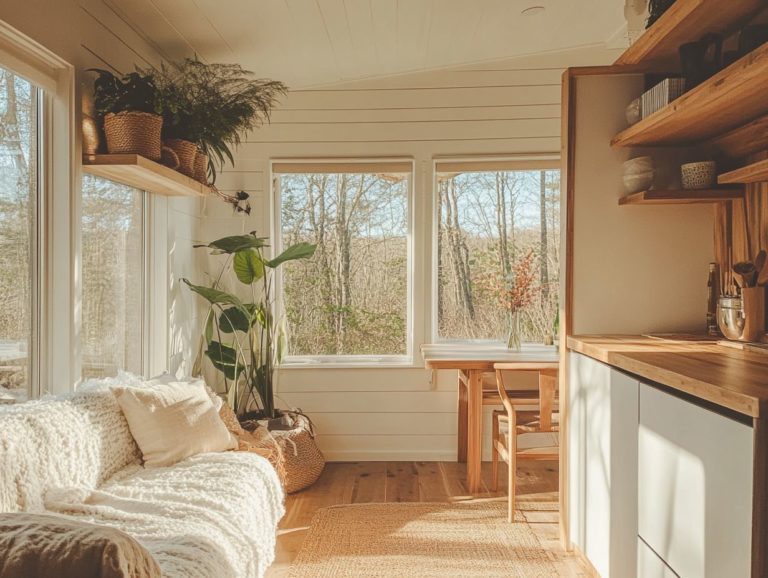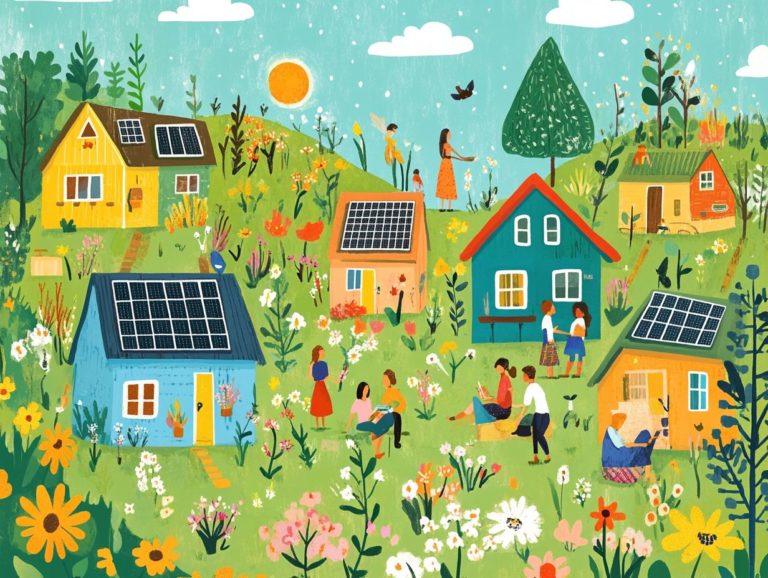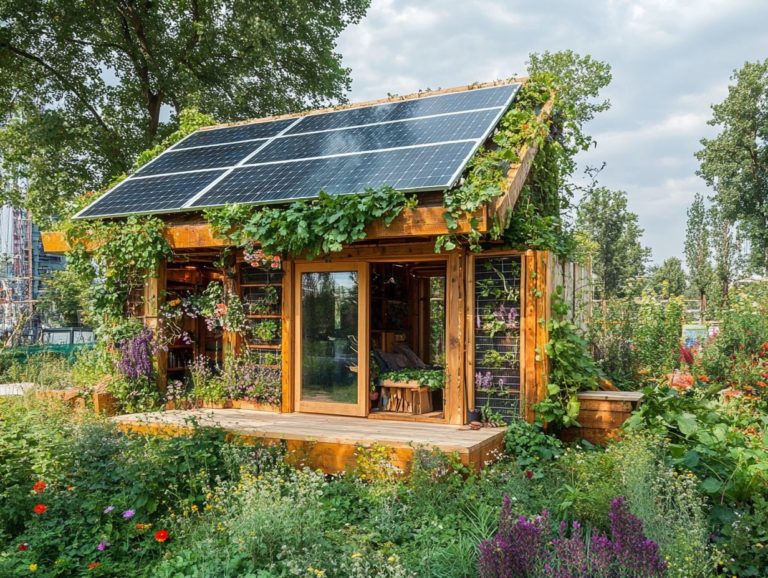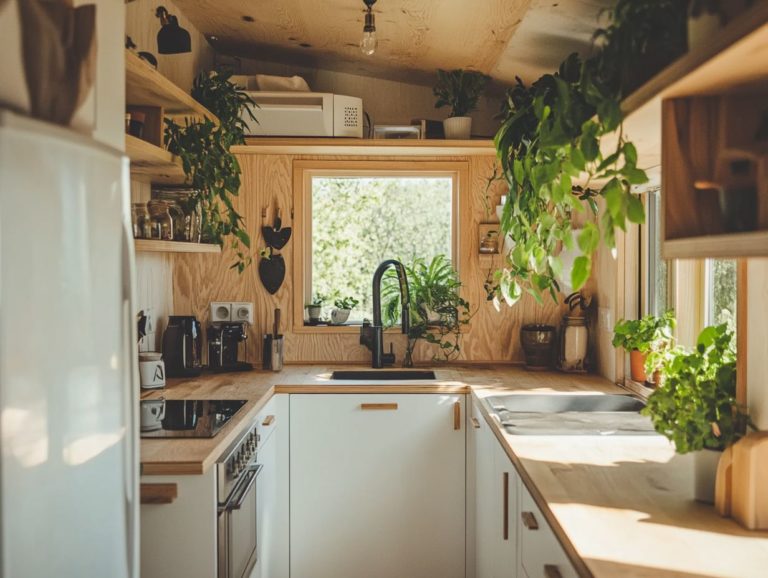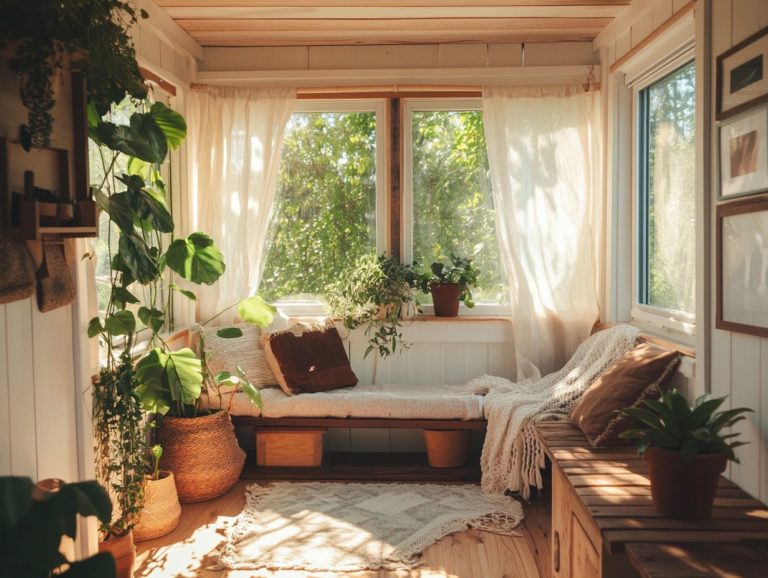5 Essential Eco-Friendly Features for Tiny Living
In a world that increasingly prioritizes sustainability, tiny living offers a remarkable opportunity to adopt an eco-friendly lifestyle.
This exploration unveils five essential eco-friendly features that can elevate your tiny home into a green sanctuary. From solar panels to composting toilets, these elements not only minimize your ecological footprint but also enhance your overall quality of life.
Delve into the benefits, the challenges, and the cost savings associated with these features. You will uncover how tiny living can seamlessly blend sustainability with style.
Contents
- Key Takeaways:
- 1. Solar Panels
- 2. Composting Toilet
- 3. Rainwater Harvesting System
- 4. Energy-Efficient Appliances
- 5. Sustainable Building Materials
- How Can Eco-Friendly Features Benefit Tiny Living?
- What Are Some Other Eco-Friendly Features to Consider?
- How Can Tiny Living Contribute to Sustainable Living?
- What Are the Challenges of Implementing Eco-Friendly Features in Tiny Homes?
- How Can One Make Their Tiny Home More Energy-Efficient?
- What Are the Cost Savings of Incorporating Eco-Friendly Features in Tiny Living?
- Frequently Asked Questions
- What are the 5 essential eco-friendly features for tiny living?
- How do solar panels contribute to eco-friendliness in tiny living?
- Why is a composting toilet a must-have eco-friendly feature for tiny living?
- What are the benefits of having a rainwater harvesting system in a tiny home?
- How can energy-efficient appliances contribute to eco-friendliness in tiny living?
- What are some examples of sustainable building materials for tiny homes?
Key Takeaways:
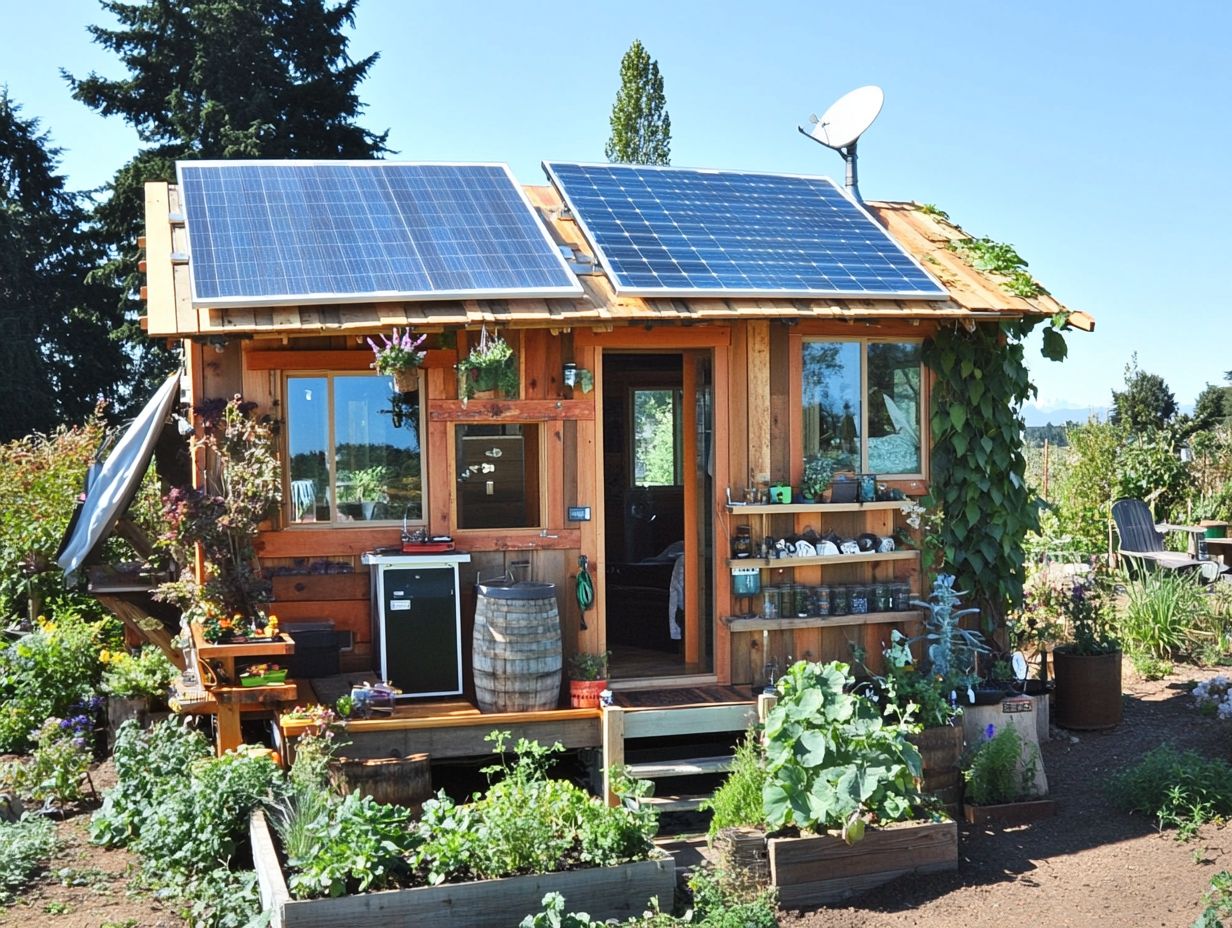
- Solar panels provide clean and renewable energy, reducing carbon footprint and electricity costs for tiny living.
- A composting toilet reduces water usage and produces nutrient-rich fertilizer for sustainable waste management in tiny homes.
- Rainwater harvesting systems conserve water and reduce reliance on municipal water sources, making tiny living more self-sufficient.
1. Solar Panels
In recent years, you may have noticed a remarkable surge in the adoption of solar panels. They are an increasingly popular choice for eco-friendly tiny homes and sustainable living initiatives.
This trend contributes significantly to energy independence while helping to reduce environmental footprints.
Solar panels promise impressive savings on your energy bills and boost energy efficiency by leveraging the capabilities of natural resources. You can easily integrate solar systems with appliances that use less energy, optimizing the power you generate.
There are various types of solar panels available, including monocrystalline and polycrystalline options, each tailored to unique needs and budgets.
The installation process is often straightforward and can be customized to fit different roof types, ensuring compatibility with your existing structure. Solar panels can seamlessly connect with other eco-friendly upgrades, such as energy-efficient lighting and smart technologies.
This allows you to create a cohesive energy-saving ecosystem within your home.
2. Composting Toilet
A composting toilet is an essential eco-friendly upgrade that significantly enhances your water conservation efforts.
This innovative solution minimizes water waste while making it an ideal choice for sustainable tiny homes. It reduces your reliance on traditional plumbing systems.
By recycling human waste into valuable compost, these systems support a circular economy and alleviate the strain on municipal sewage treatment plants.
You ll also appreciate how composting toilets can improve indoor air quality by reducing odors and encouraging better ventilation.
There are versions available, including self-contained and central systems, each tailored to suit different needs and spaces.
For homeowners, installation typically involves straightforward plumbing adjustments and venting considerations. With regular maintenance, like balancing carbon-rich materials, you can ensure these systems operate smoothly.
This provides an eco-friendly sanitation option that perfectly aligns with your sustainable living ideals.
3. Rainwater Harvesting System
Installing a rainwater harvesting system transforms your tiny home into a true eco-friendly haven!
This system conserves water while embracing eco-friendly living through reusing water from sinks and showers and thoughtful resource management.
Such systems reduce your dependence on municipal water supplies and tap into a completely free resource that generously falls from the sky.
By selecting from various types of storage tanks whether above-ground, underground, or cisterns you can customize your setup to perfectly fit your space and requirements.
When paired with advanced filtration methods, these systems ensure that the collected rainwater is clean and safe for uses ranging from irrigation to flushing toilets.
Integrating low-flow fixtures and tankless water heaters amplifies the benefits of this system, leading to significant reductions in both water usage and energy costs. Ultimately, this fosters a more sustainable lifestyle that aligns with your values.
4. Energy-Efficient Appliances
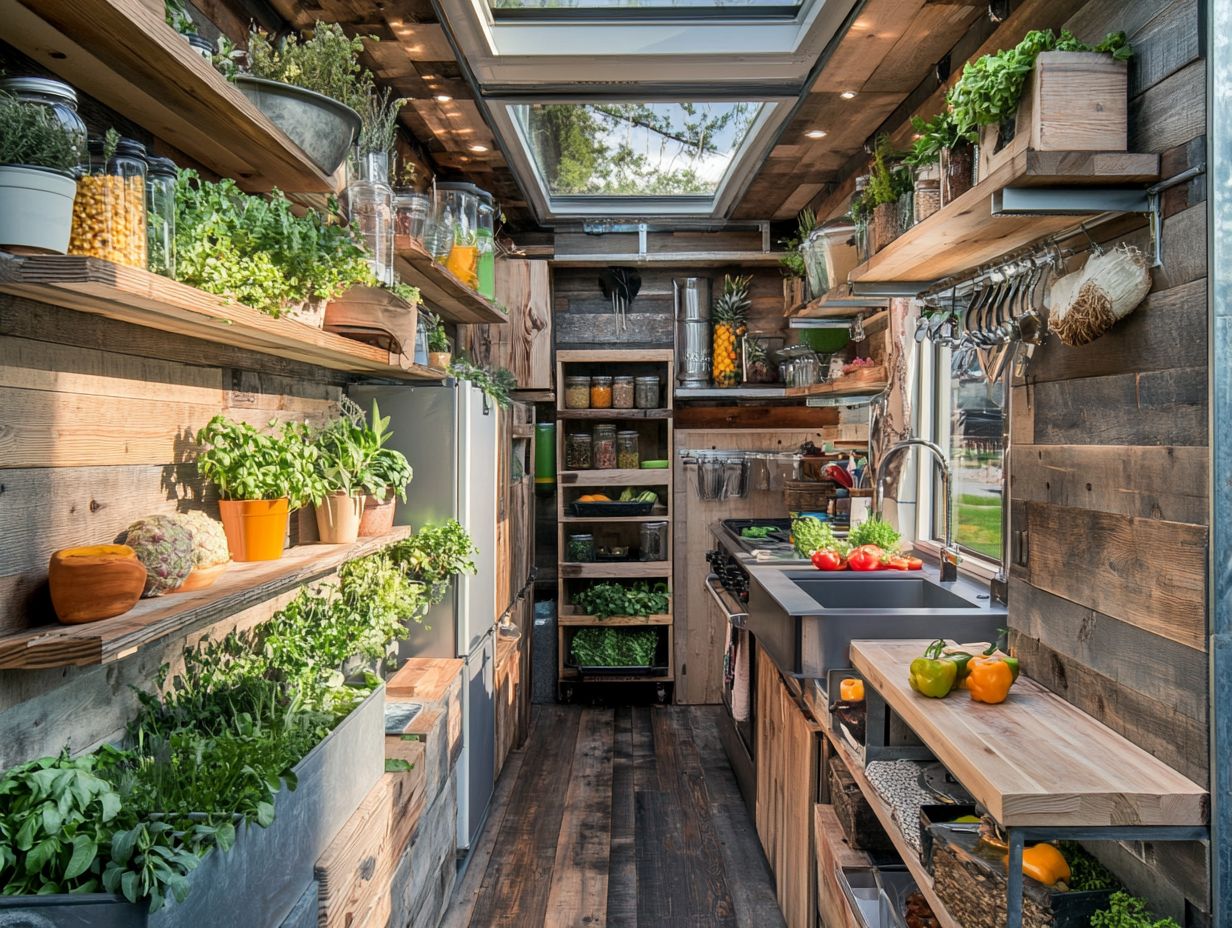
Adding energy-efficient appliances to your tiny home boosts sustainability and saves you money on energy bills. This shift promotes a more eco-friendly lifestyle and enhances your financial well-being.
Choosing Energy Star-rated appliances means you ll love how these devices use less electricity without sacrificing performance. Whether it’s washers, refrigerators, or heating and cooling systems, these appliances cut down energy consumption and improve indoor air quality by reducing pollutants and moisture levels.
When you combine these efficient appliances with renewable energy sources like solar panels, their benefits multiply. They harness solar power to meet your energy needs, easing the strain on the grid. This thoughtful pair maximizes your savings and supports a healthier planet.
5. Sustainable Building Materials
Choosing sustainable building materials, such as reclaimed materials and bamboo flooring, is crucial for reducing the environmental impact of tiny homes while enhancing their eco-friendliness and durability.
Options like recycled metal, known for its strength and longevity, and wool insulation, which offers excellent thermal performance, can significantly boost your home’s energy efficiency. Using local resources cuts transportation emissions and supports community economies. Additionally, considering designing a tiny house for sustainability can further enhance your eco-friendly efforts.
Materials like straw bales and rammed earth can further improve air quality, leading to healthier living spaces. With each thoughtful choice, you’ll help create a smaller carbon footprint while enjoying the lasting benefits of these eco-friendly options.
How Can Eco-Friendly Features Benefit Tiny Living?
<pAdding eco-friendly features to your tiny home not only makes it more sustainable but also encourages a minimalist lifestyle that promotes independence and reduces your environmental footprint.
These upgrades can lead to major savings on your utility bills, allowing you to invest in experiences rather than excess consumption. Improved indoor air quality is another great perk. Using non-toxic materials and superior ventilation systems fosters a healthier living environment. Additionally, implementing smart storage solutions for tiny homes can further optimize your space.
Consider a couple who switched from traditional heating to energy-efficient solar panels. They not only slashed their utility costs but also reduced their reliance on fossil fuels. The creativity involved in designing compact spaces often results in innovative storage solutions that maximize every square inch, showcasing how sustainable living can lead to unique home organization. When it comes to small spaces, incorporating must-have features in your tiny house bathroom can further enhance functionality.
What Are Some Other Eco-Friendly Features to Consider?
Beyond solar panels and composting toilets, there are numerous eco-friendly features that can improve both the functionality and sustainability of tiny homes. Innovative insulation techniques and adding natural light through skylight installations are just the start.
High-efficiency appliances are critical for energy conservation, helping you cut down electricity consumption without compromising performance. Smart technologies for energy management take this a step further, letting you monitor and adjust your energy use in real-time, promoting a more sustainable lifestyle.
Outdoor solar lights not only brighten your pathways but also reduce your reliance on grid electricity, further enhancing your greener footprint. Together, these features boost comfort and create a healthier living environment, allowing you to enjoy modern conveniences while minimizing your impact on the planet.
How Can Tiny Living Contribute to Sustainable Living?
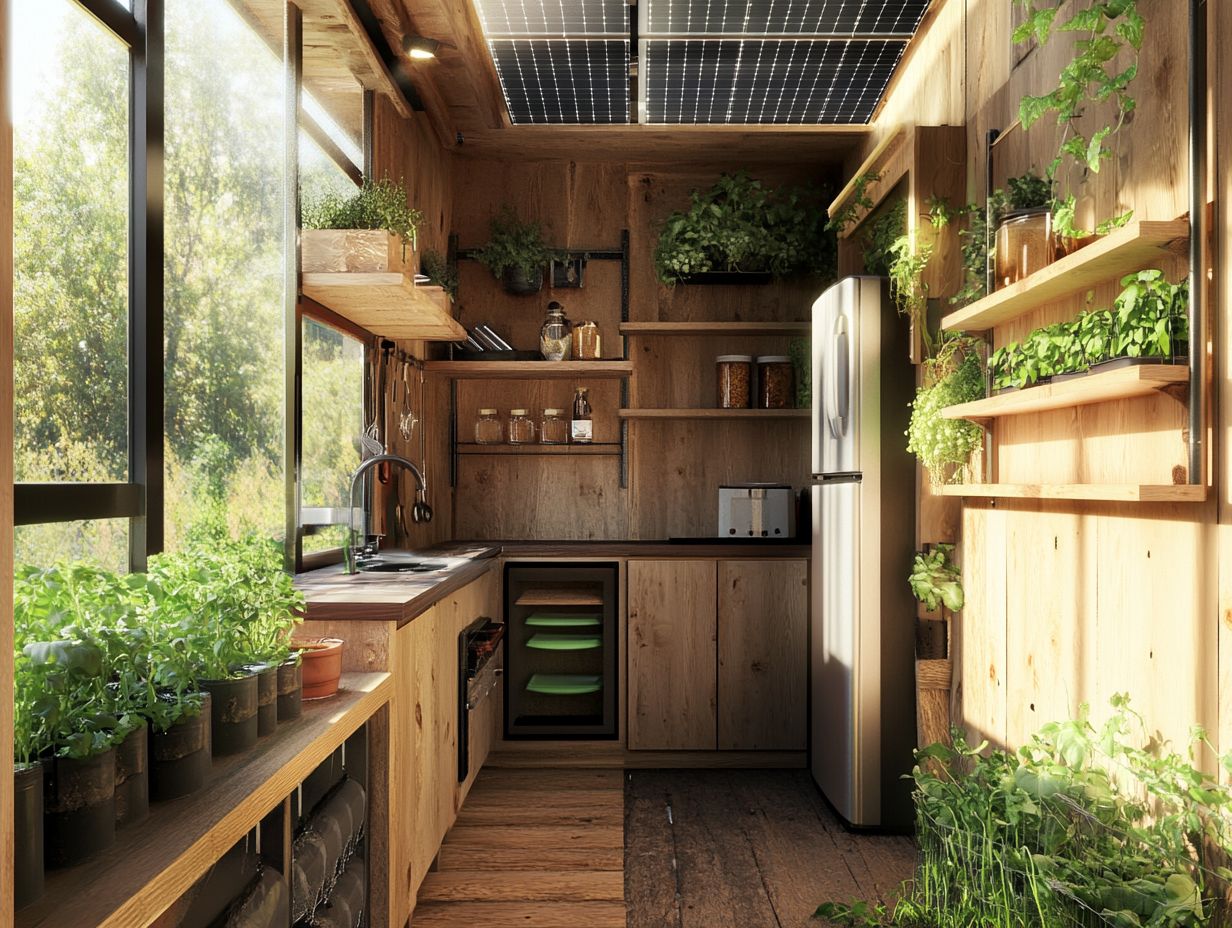
Tiny living serves as a powerful catalyst for sustainable living, emphasizing minimalism through smart design and mobility while encouraging reduced consumption and a smaller ecological footprint.
By downsizing your possessions, you may find yourself more in tune with your surroundings. This fosters a deeper connection to nature. The compact nature of these homes often prompts you to be more intentional about what you own, leading to a decluttered mind and space. Additionally, you can explore 5 ways to integrate technology into tiny house living for a more efficient lifestyle.
The mobility that comes with tiny homes presents a unique opportunity to forge community bonds. You can easily relocate to various eco-friendly developments or cooperative living spaces. This flexibility not only enhances your social interactions but also nurtures a communal spirit, where sharing resources and experiences becomes a fundamental aspect of daily life. To maximize your tiny living experience, consider exploring 5 strategies for designing a cozy tiny home.
What Are the Challenges of Implementing Eco-Friendly Features in Tiny Homes?
While there are many eco-friendly features for tiny homes, you may face some challenges. These include the constraints of compact design and the necessity for innovative solutions to effectively integrate advanced systems.
Budget constraints often arise, making it essential to discover cost-effective options that don’t compromise on quality. Space limitations can pose obstacles to installing certain eco-friendly technologies, like solar panels or greywater recycling (the reuse of water from sinks and showers) systems. Careful planning and a dash of creativity are needed. To enhance your tiny house style, consider incorporating fun accessories. Regulatory hurdles, such as zoning laws and building codes, can complicate your efforts to adopt sustainable practices.
To navigate these challenges, consider exploring some of the many smart design solutions for tiny house living available:
- Explore grants and subsidies for renewable energy projects
- Collaborate with architects who specialize in small spaces that incorporate multi-functional furniture
- Discover successful case studies where innovative designs have tackled similar obstacles and utilized sustainable house materials, including sustainable design practices for tiny houses
These insights can help you create an amazing sustainable tiny home while enhancing your minimalist lifestyle.
How Can One Make Their Tiny Home More Energy-Efficient?
Enhancing energy efficiency in your tiny home can be achieved through a range of thoughtful strategies. By implementing passive solar design principles and selecting high-efficiency appliances, you can promote energy independence and embrace sustainable living.
Incorporating energy-efficient lighting not only reduces energy consumption but also creates a warmer, more inviting atmosphere in your home. Innovative insulation techniques play a crucial role in maintaining consistent indoor air quality and temperatures, significantly cutting down on heating and cooling costs. For those living in smaller spaces, consider these 5 essential tips for efficient tiny house layouts to optimize your setup.
Adopting natural ventilation strategies and skylight installation optimizes airflow and natural light. This allows fresh air to circulate without heavily relying on mechanical systems. Collectively, these methods lead to substantial long-term savings while enhancing your comfort, ensuring that your tiny home remains a cozy and efficient haven throughout the year.
Start your journey toward a sustainable tiny home today! Every small step counts.
What Are the Cost Savings of Incorporating Eco-Friendly Features in Tiny Living?
Eco-friendly features in your tiny living space can lead to significant cost savings over time. You’ll see lower utility bills, thanks to energy-efficient appliances and recycled materials.
This commitment to sustainability supports a greener planet and offers financial benefits. For instance, investing in solar panels and tankless water heaters may require an upfront cost, but the long-term savings on energy can be substantial.
Many government incentives and rebates are available. These programs can help offset installation costs and speed up your return on investment.
Frequently Asked Questions
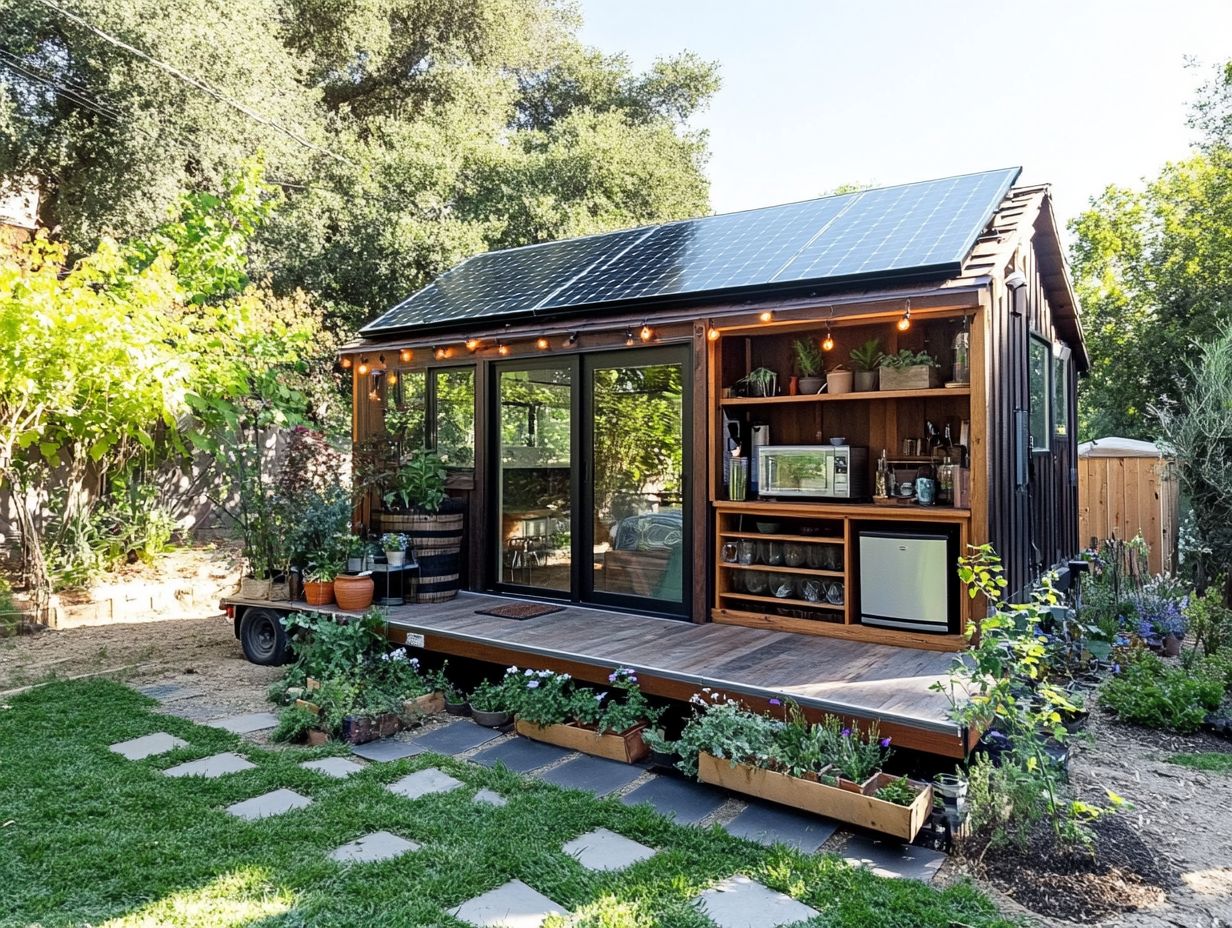
What are the 5 essential eco-friendly features for tiny living?
The five must-have eco-friendly features for tiny living are solar panels, composting toilets, rainwater collection systems, energy-efficient appliances, and sustainable materials like bamboo flooring.
How do solar panels contribute to eco-friendliness in tiny living?
Solar panels use energy from the sun to power your tiny home. This reduces your dependence on traditional energy sources and lowers your carbon footprint.
Why is a composting toilet a must-have eco-friendly feature for tiny living?
A composting toilet uses no water and requires no plumbing. This means less water usage and a cleaner environment.
What are the benefits of having a rainwater harvesting system in a tiny home?
A rainwater harvesting system collects and stores rainwater for various uses, like flushing toilets or watering plants. This reduces your reliance on treated water and maximizes space.
How can energy-efficient appliances contribute to eco-friendliness in tiny living?
Energy-efficient appliances consume less power, which lowers your electricity bill. They also help improve indoor air quality.
What are some examples of sustainable building materials for tiny homes?
Sustainable building materials include bamboo, reclaimed wood, straw bales, and recycled materials. These options have a lower environmental impact than traditional materials.

